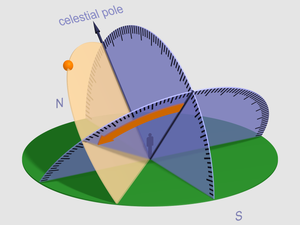
Back زاوية ساعية Arabic Ángulu horariu AST Angle horari Catalan Hodinový úhel Czech Timevinkel Danish Stundenwinkel German Ωρική γωνία Greek Ángulo horario Spanish Tunninurk Estonian زاویه ساعتی Persian
This article needs additional citations for verification. (April 2018) |

In astronomy and celestial navigation, the hour angle is the dihedral angle between the meridian plane (containing Earth's axis and the zenith) and the hour circle (containing Earth's axis and a given point of interest).[1]
It may be given in degrees, time, or rotations depending on the application. The angle may be expressed as negative east of the meridian plane and positive west of the meridian plane, or as positive westward from 0° to 360°. The angle may be measured in degrees or in time, with 24h = 360° exactly. In celestial navigation, the convention is to measure in degrees westward from the prime meridian (Greenwich hour angle, GHA), from the local meridian (local hour angle, LHA) or from the first point of Aries (sidereal hour angle, SHA).
The hour angle is paired with the declination to fully specify the location of a point on the celestial sphere in the equatorial coordinate system.[2]
- ^ U.S. Naval Observatory Nautical Almanac Office (1992). P. Kenneth Seidelmann (ed.). Explanatory Supplement to the Astronomical Almanac. Mill Valley, CA: University Science Books. p. 729. ISBN 0-935702-68-7.
- ^ Explanatory Supplement (1992), p. 724.
© MMXXIII Rich X Search. We shall prevail. All rights reserved. Rich X Search